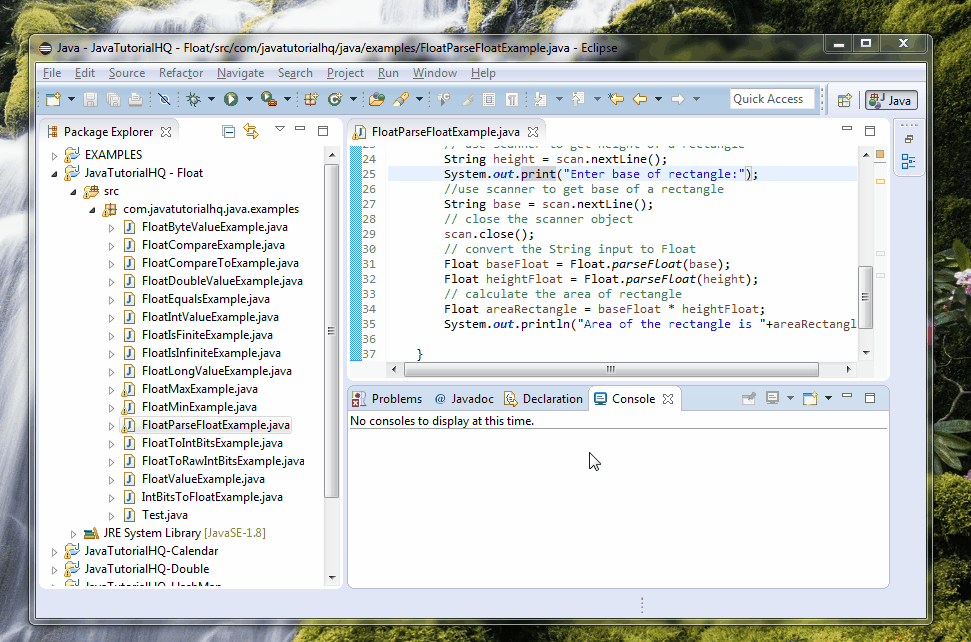java.lang.Float parseFloat(String s)
Float.parseFloat in java Overview
Float.parseFloat(method args)
Non static method is usually called by just declaring method_name(argument) however in this case since the method is static, it should be called by appending the class name as suffix. We will be encountering a compilation problem if we call the java parseFloat method non statically.
Java Float.parseFloat method Syntax
public static float parseFloat(String s) throws NumberFormatException
Method Argument
| Data Type | Parameter | Description |
|---|---|---|
| String | s | the float value represented by the string argument. |
Method Returns
The parseFloat(String s) method of Float class returns a new float initialized to the value represented by the specified String, as performed by the valueOf method of class Float.
Compatibility
Java 1.2
Discussion
The method parseFloat(String s) just parse the String input s and eventually return a Float object. As you would have noticed, the String method argument should be a number which means it should be consists by our counting numbers. It is understood that the string input should be consisting of decimal numbers only otherwise invoking the Float.parseFloat method would throw a NumberFormatException.Let’s take the following code snippet:
Float fValue= Float.parseFloat("103");
System.out.println(fValue);
The above code result will give an output of 103. As you would have noticed, we just convert the string “103” into a Float object using the static method Float.parseFloat. You might be wondering what if we put a letter or any other characters beside numbers. The method parseFloat would throw NumberFormatException. Like for this example:
System.out.println(Float.parseFloat("A"));
Running the above code would result to:
Exception in thread "main" java.lang.NumberFormatException: For input string: "A" at sun.misc.FloatingDecimal.readJavaFormatString(FloatingDecimal.java:2043) at sun.misc.FloatingDecimal.parseFloat(FloatingDecimal.java:122) at java.lang.Float.parseFloat(Float.java:451) at com.javatutorialhq.java.examples.Test.main(Test.java:6)
The above exception will be encountered if the input is not a recognizable value by Float class. If we are asking for a user input, it might be good to catch this exception and return a more user-friendly message.
Java Float.parseFloat maximum and minimum value
There is always a limit on what we could parse. You might be wondering how to determine the maximum and minimum value that is allowable by the parseFloat method. Well getting the threshold is quite easy and can be determine by using the two static values available in Float class which is the following:
Float.MAX_VALUE Float.MIN_VALUE
Let’s take an example that crosses the minimum and maximum value that we could parse using the Float.parseFloat java method:
System.out.println(Float.parseFloat("3.6028235E38"));
Running the above code would result to the following:
Infinity
Java Float parseFloat(String s) Example
Below is a simple java example on the usage of parseFloat(String s) method of Float class.
package com.javatutorialhq.java.examples;
import java.util.Scanner;
import static java.lang.System.*;
/*
* This example source code is used to calculate
* the area of a rectangle making use of
* parseFloat(String s) method of Float class
* to get the user input.
*
*/
public class FloatParseFloatExample {
public static void main(String[] args) {
// Ask user input
System.out.print("Enter height of rectangle:");
// declare the scanner object
Scanner scan = new Scanner(System.in);
// use scanner to get height of a rectangle
String height = scan.nextLine();
System.out.println("Enter base of rectangle:");
//use scanner to get base of a rectangle
String base = scan.nextLine();
// close the scanner object
scan.close();
// convert the String input to Float
Float baseFloat = Float.parseFloat(base);
Float heightFloat = Float.parseFloat(height);
// calculate the area of rectangle
Float areaRectangle = baseFloat * heightFloat;
System.out.println("Area of the rectangle is "+areaRectangle);
}
}
Basically on the above example, we just ask for two values (base and height ) as user input on the console as String format. These values as it is in String format and we cannot use it to calculate the area, thus we transformed these values into Float using the parseFloat(String s) method before doing the mathematical calculation to get the area.

